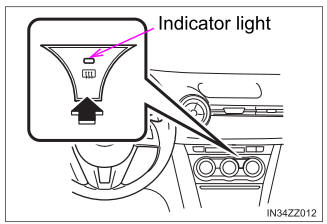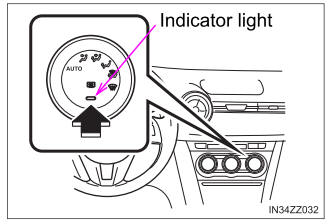Toyota Yaris: Switches and Controls / Rear Window Defogger
The rear window defogger clears fog from the rear window.
The ignition must be switched ON to use the defogger.
Press the switch to turn on the rear window defogger. The rear window defogger operates for about 15 minutes and then turns off automatically.
The indicator light illuminates when the defogger is operating.
Play at SpinBet for top online casino games and bonuses in New ZealandTo turn off the rear window defogger before the 15 minutes has elapsed, press the switch again.
Manual Climate Control

Fully Automatic Climate Control

This defogger is not designed for melting snow. If there is an accumulation of snow on the rear window, remove it before using the defogger.
NOTICE
Do not use sharp instruments or window cleaners with abrasives to clean the inside of the rear window surface. They may damage the defogger grid inside the window.
Mirror Defogger (if equipped)
To turn on the mirror defoggers, switch the ignition ON and press the rear window defogger switch.
 Rear Window Wiper and Washer (If equipped)
Rear Window Wiper and Washer (If equipped)
Turn the wiper on by turning the
rear wiper/washer switch.
Rear Window Washer
To spray washer fluid, turn the rear wiper/washer switch to either of
the
position...
 Hazard Warning Flasher
Hazard Warning Flasher
The hazard warning lights should always be used when you stop
on or near a roadway in an emergency.
The hazard warning lights warn
other drivers that your vehicle is a
traffic hazard and that they must
take extreme caution when near
it...
Other information:
Toyota Yaris XP210 (2020-2026) Reapir and Service Manual: Calibration
CALIBRATION NOTICE: When the AWD ECU assembly is replaced, before removing the AWD ECU assembly, it is necessary to perform ECU Data Save to save the original AWD ECU assembly information. When the AWD ECU assembly is replaced, it is necessary to perform the following in order: ECU Data Initialization and ECU Data Write...
Toyota Yaris XP210 (2020-2026) Reapir and Service Manual: Removal
REMOVAL PROCEDURE 1. REMOVE CENTER LOWER INSTRUMENT COVER (a) Apply protective tape to the locations shown in the illustration. Protective Tape (b) Using a screwdriver with its tip wrapped in protective tape, disengage the clip and guide to remove the center lower instrument cover as shown in the illustration...
Categories
- Manuals Home
- Toyota Yaris Owners Manual
- Toyota Yaris Service Manual
- Fuel Gauge
- Key Battery Replacement
- How to use USB mode
- New on site
- Most important about car
Supplemental Restraint System (SRS) Precautions
The front and side supplemental restraint systems (SRS) include different types of air bags. Please verify the different types of air bags which are equipped on your vehicle by locating the “SRS AIRBAG” location indicators. These indicators are visible in the area where the air bags are installed.
The air bags are installed in the following locations:
The steering wheel hub (driver air bag) The front passenger dashboard (front passenger air bag) The outboard sides of the front seatbacks (side air bags) The front and rear window pillars, and the roof edge along both sides (curtain air bags)